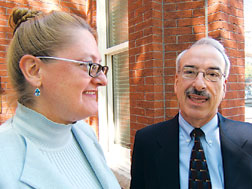...but instead limits the indemnity “to the extent caused by the negligent acts of omissions” of the subcontractor and its subs. This represents “a great improvement over clauses seen in most contracts,” wrote R. Russell O’Rourke, an attorney, in an ASA journal published in early summer.
 Guy Lawrence ASA�s Nelson (left) says that each of the participating groups had an equal voice.
|
ConsensusDOCS forms also provide for a limited waiver of consequential damages. “The owner wants to be made whole and the specialty contractor wants to cap liability so its whole business is not at risk,” says Perlberg. So ConsensusDOCS provides for a limited mutual waiver except for damages itemized as liquidated damages, he explains.
There apparently is concurrence between ConsensusDOCS and AIA when it comes to payment security for subcontractors. For example, the ConsensusDOCS subcontract and the forthcoming AIA updated documents require the contractor to pay each subcontractor within seven days after payment is received from the owner. AIA already had largely eliminated the “pay-if-paid” approach to subcontractor payment in its 1997 version of its agreements, and AIA’s new documents will continue many of these concepts, reports David R. Hendrick, another attorney writing for the ASA’s journal.
ConsensusDOCS also establishes the subcontractor’s right to be paid no matter whether the owner has paid the prime contractor. In agreeing to that provision, AGC abandons the “pay-if-paid” clause in its current standard agreement, notes O’Rourke.
Hendrick writes that AIA’s forthcoming updated documents tend to heap more risk on subs than the older versions while ConsensusDOCS contract forms tend to diminish subcontractor risks.
 |
| SANDHERR |
One of the groundbreaking aspects of the ConsensusDOCS effort is the participation of a large number of owner associations, including the National Association of State Facilities Administrators, Construction Users Roundtable, Construction Owners Association of America, Construction Industry Round Table and Building Owners and Managers Association.
“There is a growing frustration in the industry that parties, owners in particular, are presented with heavily modified standard-form documents that hardly resemble the original text,” notes a primer from ConsensusDOCS. “Parties often perceive standard documents ultimately drafted by a singular organization as protective of that organization.” Contract chaos results.
Ricardo Aparicio, president of CURT and a contracts manager for General Electric, says there has been a perception that it’s “easy for an owner to dictate terms of contracts because the owner has the money and can dictate and that doesn’t allow for dialogue.” Dialogue, not power, is what’s best, he says. With ConsensusDOCS, “we get a framework and parties are able to use risk-allocation formulas according to what makes the most sense.”
Adds Boyd Black, a director of the Construction Owners Association of America: “These documents force communication and dialogue and get us away from litigation.”
“The ConsensusDOCS drafting process was similar to negotiations for a specific project contract,” says the ConsensusDOCS group. “Parties with different viewpoints who have a large stake in the project each had a vote before the contract was ‘signed off.’ There was synergy gained from these various view points.”


Post a comment to this article
Report Abusive Comment